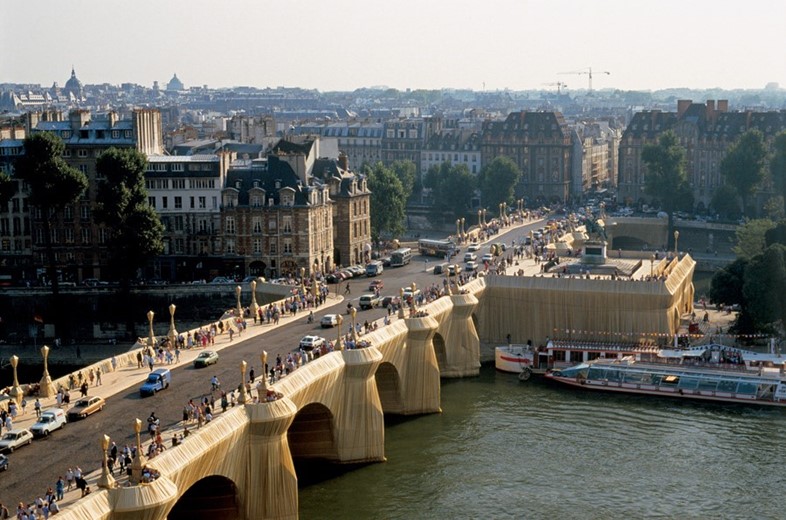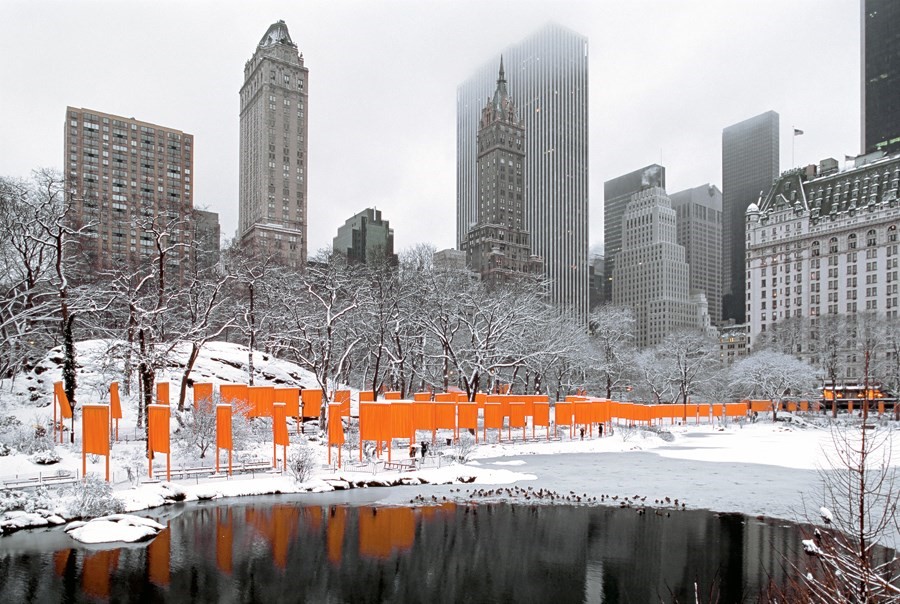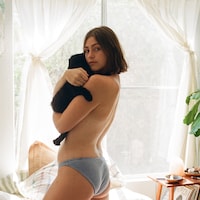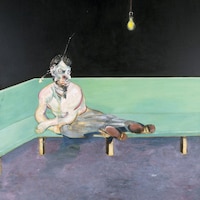The radical artists and lovers turned landmarks from Berlin’s Reichstag to New York’s Central Park gates into monumental artworks
In 1958, Christo Vladimirov Javacheff moved to Paris and met Jeanne-Claude, a Moroccan-born French woman who had studied philosophy at the University of Tunis. The young Bulgarian artist received a commission to paint a portrait of her mother and fell in love with the vibrant redhead, who serendipitously shared his birthday: the 13th of June, 1935. Fate conspired to unite this extraordinary pair of Geminis, who worked together until Jean-Claude’s death in 2009, transforming the experience of public art into something equal parts powerful and profound.
“I have a real need to appropriate reality,” Christo reveals in the stunning new book Christo and Jeanne-Claude: Urban Projects (D.A.P./Verlag Kettler), the first volume to give a comprehensive account of their work inside cities around the globe.
“The real is the real. The work is not a photograph, a film, or an image. It is the real thing” – Christo
“The real is the real. The work is not a photograph, a film, or an image. It is the real thing,” Christo says, speaking with passion over the phone from the US. “This is because I have the enormous visceral pleasure of the real thing. I understand many people do not like to be in an uncomfortable place that is windy, hot, boring, because it is demanding of your effort, but if you have a physical pleasure to only do things like that (laughs), you understand. It is something.”
That something is the seed of an idea that is planted and takes root, developing over a period of years and even decades into large-scale installations that reframe the way we look, see, and perceive art, architecture, and our place in the landscape. The pair’s dazzling and sometimes controversial projects include “Wrapped Reichstag” in Berlin (1995), “The Pont-Neuf Wrapped” in Paris (1985), and “The Gates” in New York’s Central Park (2005) – projects that celebrate the power of the individual to exact their will upon the physical world, for the sheer pleasure that aesthetics presents.

On June 18, Christo revealed his first outdoor public work in the UK, “The London Mastaba”, which floats on the Serpentine Lake until September 23. The work, built by a team of experienced engineers, consists of 7,506 horizontally stacked barrels on a 30 x 40-meter floating platform that occupies approximately 1 per cent of the total surface area of the lake. The installation runs concurrently with Christo and Jeanne-Claude: Barrels and The Mastaba 1958-2018 at Serpentine Galleries through September 9.
“The London Mastaba” is in compliance with national and local policy so that it will have no negative ecological impact on the lake, the park, or wildlife. What’s more, its creation has inspired new ecological projects to support the habitats of birds, bats, and lake algae.
This level of awareness is an essential feature of the work of Christo and Jeanne-Claude. For the pair, every single aspect of the project – from conceptualisation to execution – is an integral part of the experience of the work. “Some of the projects involve a lot of complexity, and this is why the work needs to adjust to the people who are living their everyday lives there,” Christo explains.
“I have a real need to appropriate reality” – Christo
“We think very little about the space for the visual arts. The moment you walk out of your home, walk on the sidewalk to go down the street, everything you encounter is designed by somebody. Basically, 24-hours a day we are in a highly controlled space. We are never thinking about it because it is inconvenient, but that is how we live. It was always our assertion that we have to borrow that space and create gentle disturbances for a few days. We inherit everything inherent to that space so that it is part and parcel of the work of art. We don’t invent anything.”
While they may not be inventors, Christo and Jeanne-Claude have been catalysts for thinking and agents of change, transforming the possibilities of art in the public arena. “All of our projects are very complex in a political sense and (in regards to) human relations. They deal with the real things, not the image on a screen. I do not know how to open the computer; I am not interested in it. I don’t even like to talk on the telephone,” Christo reveals.
His is a preference for the human realm – one that is rooted in the body and the nature of sensation itself. “I have no elevator in my building where I have lived for 50 years, and I walk all day. I am choosing that physical pleasure. Of course, it is difficult to persist. All of this is part of why this project is about that type of relationship with space. All the energy of the project is revealed through the permitting process,” he says.
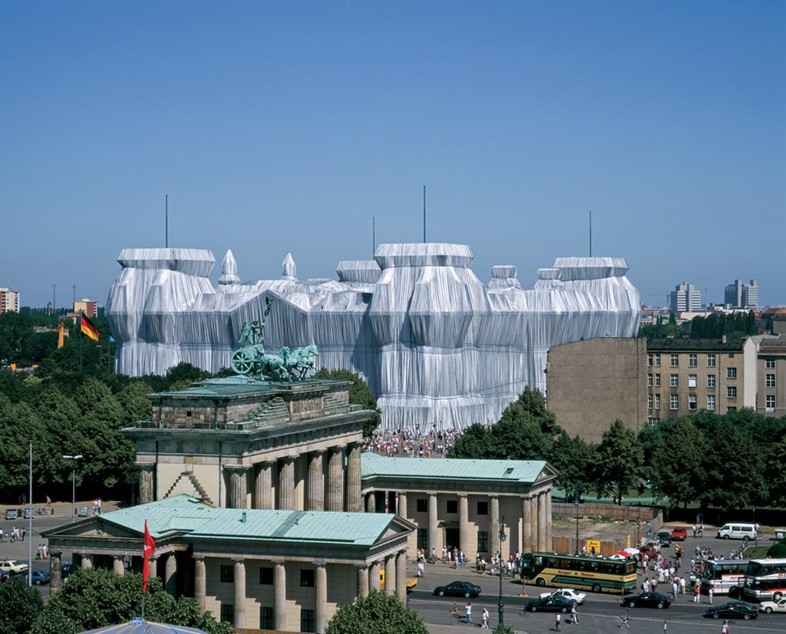
“We began working on the Reichstag (Berlin, Germany) in 1972. It took us 25 years to complete. For years and years, people tried to envision how terrible it would look. They discussed this about things that did not exist. All of that created dialogue and discussions and the project became tied to an enormous interpretation in the minds of the people before it even appeared.”
Many of Christo and Jeanne-Claude’s works have been initially refused, only to be built years later. While others have never been executed at all. The book provides a detailed overview of projects including preparatory drawings, collages, and models for some projects that were never carried out, including the wrapping of the old Whitney Museum of American Art on Madison Avenue. “We have realised 23 projects and we failed to get permission for 47 projects,” Christo notes.
But once they get permission to execute their work, they are resolved never to repeat themselves. “We will never do another gate; we know how to do gates. We will never wrap another Parliament building or build another fence. These are all unique projects. It is very boring to do something when we already know how to do it,” Christo explains.
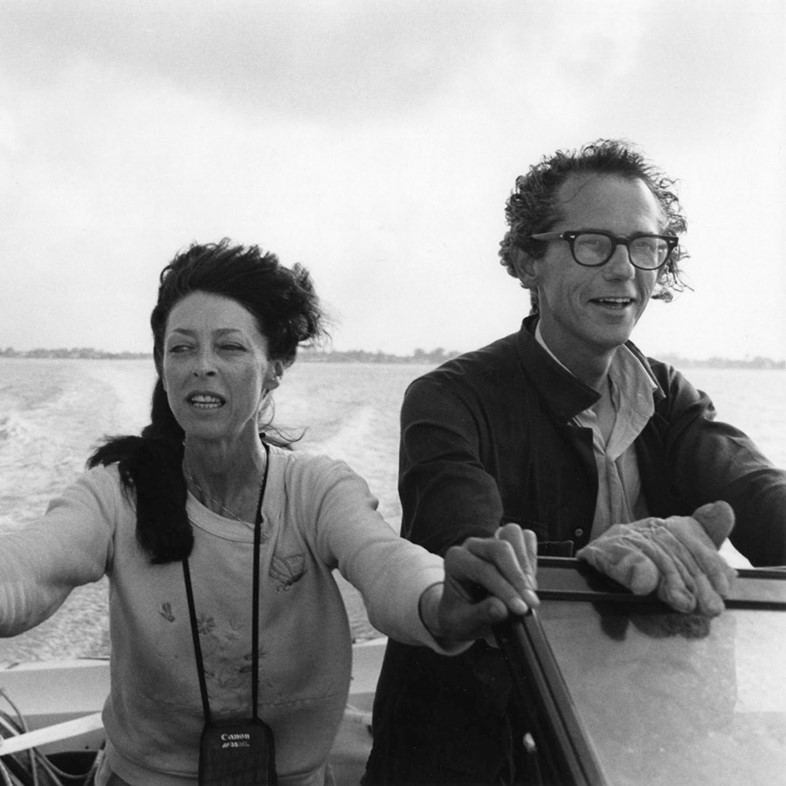
That something has taken Christo and Jeanne-Claude around the world and back, forever pushing the boundaries of the realms where art, architecture, and the environment overlap. “A very important part of the work is the expansion of the three-dimensional space, something you can walk inside like a sculpture by Alexander Calder. That space is entirely controlled by the artist, and it is organised so that you follow it,” Christo explains.
That moment of revelation to the viewer is the final mile in a marathon that makes up each art work’s journey and has involved massive teams that do everything from lobby local and federal governments for permits to engineers that execute the designs, which are ever evolving to accommodate the specific requirements of the site. The exquisite physicality of their work is intrinsic to the artists themselves, navigating the spaces between the political, the personal, and the material worlds.
Consider the wrapping of the Pont Neuf bridge, which was constructed in 1607, and has gone on to become a favourite subject for artists from Louis Daguerre to Jeanne Renoir and Pablo Picasso. “This is why we liked to take it,” Christo says with joy. “When we tried to get permission from the governments in France and Paris, our argument was that for 450 years the Pont Neuf was the subject for art – and for 14 days in 1985, it became an object of art itself!”
The London Mastaba is floating on London’s Serpentine Lake until September 23. The installation will run alongside Christo and Jeanne-Claude: Barrels and The Mastaba 1958-2018 at Serpentine Galleries until the September 9. Christo and Jeanne-Claude: Urban Projects (D.A.P./Verlag Kettler) is also available now
